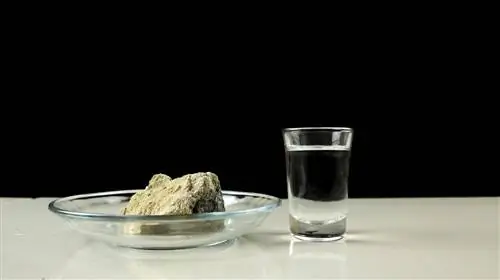- Author admin [email protected].
- Public 2023-12-16 16:46.
- Last modified 2025-01-23 11:22.
Moles are known to be protected and may neither be killed nor caught. Lawn lovers are therefore looking for an animal-friendly alternative to get rid of moles. We explain whether carbide is permissible against moles and what needs to be taken into account.

Is carbide an effective and safe method against moles?
Is carbide effective against moles? Although carbide can drive away moles through the stench it produces, the method is dangerous, harmful to the environment and, in many cases, prohibited. Better alternatives are mothballs, buttermilk or garlic in combination with acoustic expulsion methods such as wind turbines.
What is carbide?
Carbide looks like small, gray pieces of rock and is officially called calcium carbide or calcium acetylide (CaC2). When it comes into contact with water, smelly, highly flammable gases are released: including hydrogen sulfide, ammonia and monophosphine. The smell drives away moles and other unwanted garden inhabitants such as voles.
Excursus
Moles are beneficial insects
Even if moles dig up the ground, they are a real blessing for your garden: They eat insects such as grubs and caterpillars, loosen and aerate the soil and keep “real” pests such as voles away.
The danger of carbide
The gas ethyne (acetylene) produced when water and carbide react is very flammable. Anyone who drops a cigarette butt near carbide can expect an explosion. But that's not all: carbide and its gases are highly toxic and are banned in many allotments, in nature reserves and near rivers and lakes. In addition, carbide is irritating and can cause eye damage and skin injuries if used improperly. Storing carbide is a major challenge because even the slightest bit of moisture leads to the formation of toxic gases.
Carbide a good solution against moles?
Even if the use of carbide is not officially banned despite all its dangers, we strongly advise against using it against moles or other unwanted guests. Not only are you causing lasting damage to the environment, microorganisms and waterways, but you are also risking your own he alth and that of your children and pets.
Lack of effectiveness of carbide against moles
It gets even worse: Experience reports say that the use of carbide against moles is rarely successful. Therefore the risk is really not worth it.
Alternatives to carbide against moles
In principle, it is a good idea to get rid of a mole with a smell - but with a harmless agent. Harmless remedies for moles include:
- Mothballs
- Buttermilk
- garlic
Distribute the chosen remedies (more helps more!) into several mole tunnels (carefully open and close again) and renew them every few days. The stink method is most effective when you combine it with acoustic expulsion methods such as a wind turbine.






